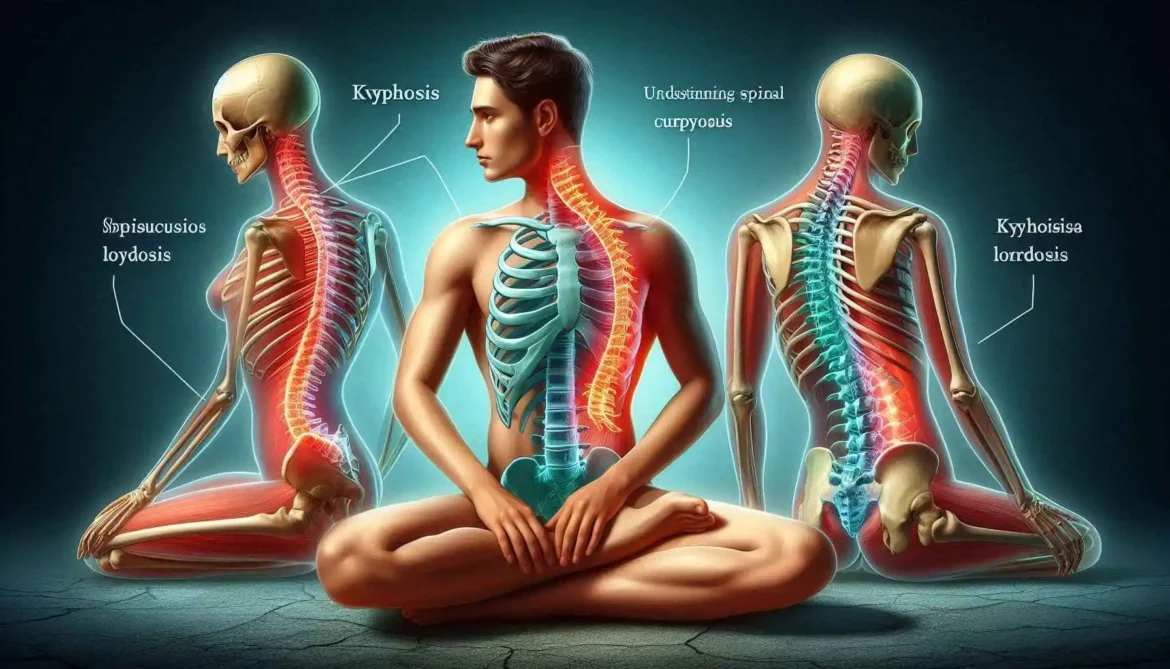We often hear terms like “swayback” or “hyperlordosis” in discussions about posture and spinal health. These terms refer to Lordosis, a condition characterized by an excessive inward curve of the lower back (lumbar spine) or, less commonly, the neck (cervical spine). While a natural curve is essential for balancing the body and absorbing shock, an exaggerated curve can lead to discomfort, pain, and other health issues. Let’s delve into what causes this condition, how we can recognize its symptoms, and the various treatment approaches available.
What Causes Lordosis?
Lordosis can stem from a variety of factors, ranging from poor posture to underlying medical conditions. From our research, some of the most common causes we identify include:
- Poor Posture: Prolonged sitting, excessive arching of the back, and wearing high heels can all contribute to an exaggerated lumbar curve over time.
- Obesity: Carrying excess weight, particularly around the abdomen, can pull the pelvis forward, increasing the curve in the lower back.
- Pregnancy: The weight of the baby and hormonal changes during pregnancy can cause a temporary lordosis, which usually resolves after childbirth.
- Osteoporosis: This condition, which weakens bones, can lead to vertebral compression fractures that alter the spinal curvature.
- Spondylolisthesis: A condition where one vertebra slips forward over another, often in the lower back, directly impacting spinal alignment.
- Discitis: Inflammation of the disc space between vertebrae, often due to infection, can sometimes lead to an altered curve.
- Achondroplasia: A genetic disorder causing dwarfism, which can result in specific spinal abnormalities, including lordosis.
Recognizing the Symptoms of Lordosis
Identifying lordosis often begins with noticing changes in one’s posture and experiencing certain physical discomforts. We typically look for the following signs and symptoms:
- Pronounced Inward Curve: The most obvious sign is a visible, exaggerated inward curve in the lower back, causing the buttocks to appear more prominent.
- Back Pain: This is a very common symptom, ranging from mild aches to severe, debilitating pain, especially in the lower back.
- Muscle Spasms: The muscles surrounding the spine may become tight and spastic as they try to compensate for the altered alignment.
- Limited Movement: In some cases, movement of the spine might be restricted or difficult.
- Nerve Compression (less common): In severe cases, the excessive curve can put pressure on spinal nerves, leading to numbness, tingling, or weakness in the legs.
As Hippocrates wisely noted, “Walking is man’s best medicine.” While exercise is crucial, ensuring proper spinal alignment during our daily activities, including walking, is paramount for spinal health.
Treatment Approaches for Lordosis
The good news is that most cases of lordosis can be effectively managed with conservative treatments. Surgical intervention is typically reserved for severe cases or when neurological symptoms are present. Our approach to treatment often involves a combination of strategies tailored to the individual’s specific needs.
Here are the primary treatment methods we consider:
| Treatment Type | Description | Common Applications |
| Physical Therapy | Exercises to strengthen core muscles, improve flexibility, and posture. | Mild to moderate cases, post-surgical recovery |
| Medication | Pain relievers (NSAIDs), muscle relaxants to manage pain and spasms. | Acute pain relief, inflammation management |
| Bracing | Custom-fitted braces to support the spine and prevent further curving. | Adolescents with progressive curves, some adult cases |
| Weight Management | Diet and exercise to reduce abdominal fat and alleviate spinal stress. | Obesity-related lordosis |
| Surgery | Spinal fusion or instrumentation to correct severe curves. | Severe cases, neurological compromise, failed conservative care |
For non-surgical management, we often recommend:
- Targeted Exercises: Focusing on core strengthening (abdominal and back muscles) and hamstring stretches.
- Heat or Cold Therapy: Applying packs to relieve pain and reduce muscle stiffness.
- Lifestyle Modifications: Adjusting posture during daily activities, using ergonomic chairs, and avoiding prolonged static positions.
In conclusion, lordosis, while potentially uncomfortable, is often manageable. Understanding its causes and symptoms is the first step towards effective treatment. If you suspect you or a loved one might have lordosis, we strongly encourage consulting a healthcare professional for an accurate diagnosis and a personalized treatment plan. Early intervention can significantly improve outcomes and enhance our overall quality of life.
Our Approach to Spinal Health
Regardless of whether it’s scoliosis or kyphosis, our overarching philosophy emphasizes early detection and a comprehensive, multidisciplinary approach to care. We believe in empowering our patients with knowledge about their condition, involving them in shared decision-making, and providing them with personalized treatment plans. Regular check-ups, especially for children and adolescents during their growth spurts, are key to identifying these conditions early, when conservative treatments are often most effective. For adults, maintaining good posture, regular exercise, and managing bone health are crucial preventive measures against degenerative forms of spinal curvature.
In conclusion, while scoliosis and kyphosis represent distinct types of spinal deformities, our commitment remains the same: to promote spinal health, alleviate discomfort, and enhance the quality of life for all those affected. Understanding these conditions is the first step towards effective management and a healthier, more aligned future.
FAQs
- What are spinal curvatures?
Spinal curvatures refer to the natural or abnormal curves in the spine, including the cervical, thoracic, lumbar, and sacral regions. Normal curvatures help absorb shock and maintain balance. - What are the types of normal spinal curves?
The spine normally has a cervical lordosis (inward curve), thoracic kyphosis (outward curve), lumbar lordosis (inward curve), and sacral kyphosis. - What is scoliosis?
Scoliosis is an abnormal lateral (sideways) curvature of the spine, often detected in adolescence. - What is kyphosis?
Kyphosis is an exaggerated outward curve of the thoracic spine, resulting in a hunched or rounded upper back. - What is lordosis?
Lordosis is an excessive inward curve of the lower back (lumbar spine), sometimes called swayback. - What causes abnormal spinal curvatures?
Causes include congenital disabilities, poor posture, neuromuscular conditions, degenerative diseases, trauma, and idiopathic reasons (unknown cause). - How can spinal curvatures affect health?
Severe curvatures can cause pain, nerve compression, breathing difficulties, and reduced mobility. - How is scoliosis diagnosed?
Through physical examination, Adam’s forward bend test, and imaging studies like X-rays or MRI. - Can spinal curves worsen over time?
Yes, especially untreated scoliosis or degenerative changes can exacerbate over months to years.
Diseases Associated with Spinal Curvatures
- What diseases are linked to spinal curvature abnormalities?
Diseases include scoliosis, kyphosis, lordosis, ankylosing spondylitis, osteoporosis-related fractures, and disc herniation. - What is ankylosing spondylitis?
A type of arthritis causing inflammation and fusion of spinal vertebrae, leading to rigidity and altered curvature. - How does osteoporosis affect spinal curvature?
Osteoporosis can lead to vertebral fractures and collapse, worsening kyphosis (dowager’s hump). - Are children at risk for spinal curvature diseases?
Yes, especially scoliosis often develops during growth spurts in adolescence. - Can poor posture cause spinal curvature diseases?
Poor posture can contribute to functional spinal curves but typically does not cause structural spinal diseases. - Is spinal curvature hereditary?
Some forms, such as idiopathic scoliosis, have genetic predisposition.
Natural Remedies for Spinal Curvatures
- Can exercise help spinal curvatures?
Yes, specific exercises can strengthen back muscles, improve posture, and reduce pain. - What types of exercises benefit spinal curvatures?
Stretching, core strengthening, yoga, Pilates, and Schroth exercises are beneficial. - Are there natural supplements for spinal health?
Supplements like calcium, vitamin D, magnesium, and collagen may support bone and joint health. - Can massage therapy help with spinal curvature discomfort?
Massage can relieve muscle tension and improve circulation but does not correct spinal deformity. - Does acupuncture help spinal curvature symptoms?
Acupuncture may reduce pain and muscle spasms associated with spinal conditions. - How does weight management affect spinal health?
Maintaining healthy weight reduces load on the spine and may prevent worsening curvature. - Is heat or cold therapy effective for spinal issues?
Yes, heat relaxes muscles and cold reduces inflammation and pain. - Can chiropractic care correct spinal curvatures?
Chiropractic adjustments can relieve joint dysfunction and pain but do not usually correct structural abnormalities.
Lifestyle Changes for Managing Spinal Curvatures
- How important is posture in managing spinal curvatures?
Maintaining correct posture reduces strain on the spine and can minimize progression of abnormal curves. - What ergonomic tips help protect the spine during daily activities?
Use proper chair support, avoid slouching, adjust computer screens to eye level, and take frequent breaks from sitting. - Can sleeping position affect spinal curvature symptoms?
Yes, sleeping on a firm mattress with proper pillow support helps maintain spinal alignment. - Is physical therapy recommended for spinal curvatures?
Yes, physical therapy is a cornerstone for treating mild to moderate curvatures, focusing on pain relief and mobility. - Can children with scoliosis benefit from bracing?
Yes, bracing can prevent progression of scoliosis in growing children. - When is surgery needed for spinal curvatures?
Surgery is considered for severe deformities causing pain, respiratory issues, or neurological symptoms. - How can stress management improve spinal health?
Stress reduction techniques like meditation and deep breathing help relax muscles and reduce pain. - What is lordosis and how can natural remedies help?
Lordosis is an excessive inward curve of the lower spine. Natural remedies and lifestyle changes can help by improving posture, strengthening core muscles, and reducing discomfort without the need for surgery or medication. - Can exercise correct lordosis naturally?
Yes, specific exercises that strengthen the abdominal and back muscles, such as pelvic tilts, bridges, and planks, can help improve spinal alignment and reduce lordosis. - Are there particular stretches recommended for lordosis?
Stretching tight hip flexors and lower back muscles is beneficial. Common stretches include lunges, hamstring stretches, and child’s pose to relieve tension and improve flexibility. - How important is posture in managing lordosis?
Maintaining proper posture is crucial. Being mindful about sitting, standing, and walking with a neutral spine helps prevent worsening of lordosis and supports spinal health. - Can weight management impact lordosis?
Yes, excess abdominal weight can pull the spine forward and worsen lordosis. Maintaining a healthy weight through diet and exercise reduces strain on the lower back. - Are there natural therapies that can relieve lordosis pain?
Yes, applying heat or cold packs, massage therapy, and practicing yoga or Pilates can help reduce muscle pain and improve spinal alignment naturally. - Should I avoid certain activities if I have lordosis?
Avoid activities that put excessive strain on the lower back, such as heavy lifting or high-impact sports, until your core strength improves and pain decreases. - How long does it take to see improvement in lordosis with natural treatments?
Improvement varies but generally, consistent exercise and lifestyle changes over several weeks to months can lead to noticeable benefits. - Can sleeping positions affect lordosis?
Yes, sleeping on your back with a pillow under your knees or on your side with a pillow between your legs helps maintain spinal alignment and reduces pressure on the lower back. - When should I see a doctor despite using natural remedies?
If you experience severe pain, numbness, weakness, or if your symptoms worsen despite natural treatments, it’s important to consult a healthcare professional for further evaluation.
Medical Disclaimer:
The information provided on this website is for general educational and informational purposes only and is not intended as a substitute for professional medical advice, diagnosis, or treatment. Always seek the advice of your physician or other qualified health provider with any questions you may have regarding a medical condition. Never disregard professional medical advice or delay in seeking it because of something you have read on this website.



